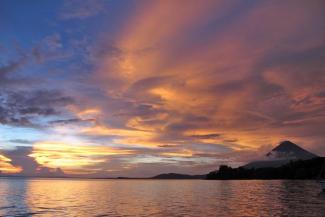Nicaragua Canal
A violation of civil liberties
 Johanna Kirchner
Johanna Kirchner
The Panama Canal, which cuts across Central America, is currently the only shipping route connecting the Atlantic and Pacific Oceans. However, it is too narrow for the newest generation of freighters. That gives Nicaragua the chance to enter the lucrative business. In 2012, the country’s parliament decided to construct its own “Interoceanic Grand Canal”. The 278-kilometre-long canal will flow through the large Lake Nicaragua. The government hopes to provide an alternative route for ships carrying more than 13,000 containers, which makes them too big for the Panama Canal.
But this dream of development and prosperity is threatening to turn into a nightmare for residents and the environment. In addition to doubting the economic feasibility of the proposed canal, activists and residents are concerned about serious environmental damage, forced resettlement and expropriation.
Poorly considered contracts
In 2012 and 2013, the government hastily prepared and signed the necessary agreements for the construction of the canal. In June 2013, it took the National Assembly just three hours to approve a bill to grant the concession – even though the contract is supposed to remain in effect for an entire century. The concession was then awarded to the HKND Group, a company registered in Hong Kong. Wang Jing, the company’s Chinese chairman, signed the deal.
Experts warn of possible pitfalls in the agreement. The HKND Group is made up of a consortium of 15 companies and corporations that were all founded by Wang Jing between 2012 and 2013 in order to manage this project. Only one of these firms is registered in Nicaragua. Five others are registered in the Cayman Islands, and the rest are registered in Europe and Asia. Only one of the companies has assets totalling more than $ 1,500. And none of them have any experience whatsoever with large-scale infrastructure projects. Experts believe that this complex corporate network will prevent any individual company from being held liable to the state. If problems arise, it will be difficult to hold the responsible parties accountable.
Far-reaching rights for the developers
The contract grants the concessionaire extensive mining and land use rights: The government will make available to the HKND Group all public and private lands that it claims to need for the canal’s construction. The government will also provide HKND with unlimited rights to natural resources like forests and groundwater, including – if needed – from other parts of the country.
Furthermore, the concessionaire has been given a generous tax exemption and legal immunity. HKND is not required to pay taxes on any construction projects associated with the canal. These include the “Canal Seco” – a railway and road link alongside the canal – a pipeline, two ports, an airport and other possible side projects. The contract also stipulates that the HKND Group may not be held liable under administrative, commercial, civil or criminal law. This provision will make it very difficult for Nicaraguan authorities to protect the rights of the people.
The company has not even had to pay a high price for all these benefits: The contract requires HKND to merely “attempt” to pay the Nicaraguan government $ 10 million a year for 10 years. Nicaragua, on the other side, will put up the reserves of its National Bank as collateral for its obligations to the concessionaire. Every year, one percent of the shares will be signed over to the Nicaraguan government. Accordingly, it will take 100 years for the country to become the sole owner of the project.
The fact that a contract that is so disadvantageous to Nicaragua and its residents was signed so unbelievably fast raises the question of who actually stands to benefit from this arrangement. It certainly doesn’t seem to be the country’s citizens.
Civil rights violations
The lack of transparency surrounding talks about the concession supports this suspicion. The CIDH, Nicaragua’s Human Rights Commission, has strongly criticised the government for not looking into the project’s impact on citizens, not to mention the fact that citizens were not involved in decision-making.
According to estimates, more than 100,000 people live in the path of the proposed canal. Many of them are indigenous groups or communities of African descent. Telémaco Talavera, the spokesman for the project, admitted in April that these people were only now about to be consulted. They will face large-scale expropriations and forced resettlement, so it seems safe to say that this consultation comes too late.
The failure to properly inform residents is all the more serious given the fact that they will not be appropriately compensated. According to the recently passed Law 840, displaced households will only receive the cadastral value of their property, which is much lower than the market value.
In general, the government seems unwilling to engage in an open and transparent debate, as evidenced by the arrest and subsequent deportation of the Belgian photojournalist Michèle Sennesael in December 2014. Before her arrest, Sennesael had gathered information about the canal project and analysed its impact on residents. She states that she was harassed by police officers and soldiers.
Environmental concerns
Environmentalists have also expressed strong criticism. They are especially concerned about the dredging that will be carried out at Lake Nicaragua. Lake Nicaragua is the largest reservoir in the region and Nicaraguans’ most important source of drinking water. With an average depth of 12.5 meters, the lake is not quite half as deep as the planned canal. Therefore engineers will have to dredge a channel that is an additional 15 meters deep, 500 meters wide and 105 kilometres long. Millions of tons of earth will have to be removed from the bottom of the lake. The dredging could seriously compromise the water quality and put flora and fauna at risk. The same is true of the water turbulences freight ships will cause once the canal becomes operational.
The proposed route of the canal, moreover, passes through the Rio San Juan Biosphere Reserve and the Cerro Silva Nature Reserve, where almost 200 hectares of forest, coastline and wetlands are likely to be destroyed. The San Miguelito wetlands, which are protected by the Ramsar Convention, an international treaty for the protection of wetlands, would be affected as well.
Experts are particularly critical of the fact that no reliable environmental impact assessment has been carried out yet. A preliminary study was conducted by Environmental Resources Management (ERM), a private firm, and completed within a matter of days. The Ministry of Environment accepted it after just one day. According to the environmental organisation Centro Humboldt, the report is very superficial. The experts from civil society argue that such an enormous project, which could jeopardise the entire country’s water supply, must be reviewed much more carefully. An independent study by Centro Humboldt concluded that the project is not environmentally sustainable.
Competition with Panama
Despite the serious risks involved, spokespeople for the project are repeatedly reassuring residents that the potential economic gains outweigh any damage that might occur. The private sector, especially the construction industry, is enthusiastic and busily producing calculations showing how profitable the mega-project will be.
But critics fear that demand might be much lower than expected. For one thing, it has already occurred to Panama to expand its canal to accommodate larger ships. The government has invested over $ 5 billion in these modifications. Furthermore, nothing is preventing it from pursuing more expansions in the future. At any rate, the economic, ecological and social costs of such a project would be significantly lower than for any new construction in Nicaragua.
Nevertheless, the Nicaragua Canal is on its way. The government celebrated the start of construction in a symbolic ceremony on 22 December 2014. However, only minor work has been performed so far – it is not entirely clear why. There is talk of tensions brewing between the authorities and the concessionaire. If this monster project is ever actually carried out, it will be seen as a mausoleum of monumental proportions in which the civil liberties of the Nicaraguan people lie buried.
Cecilia Medal Salaverry is a feminist and sociologist from Nicaragua and a member of the Aula Propia collective. csalaverry@gmail.com


